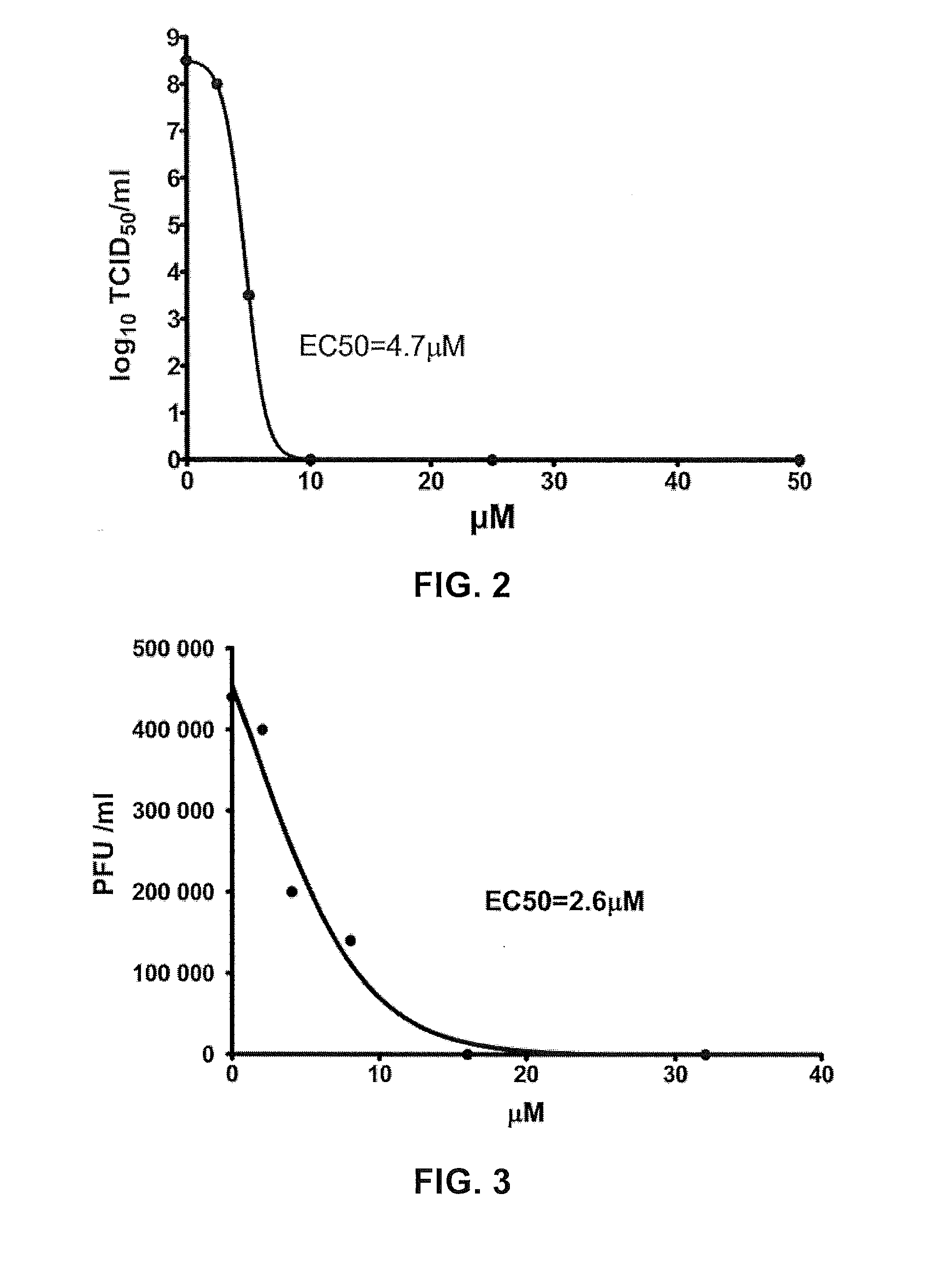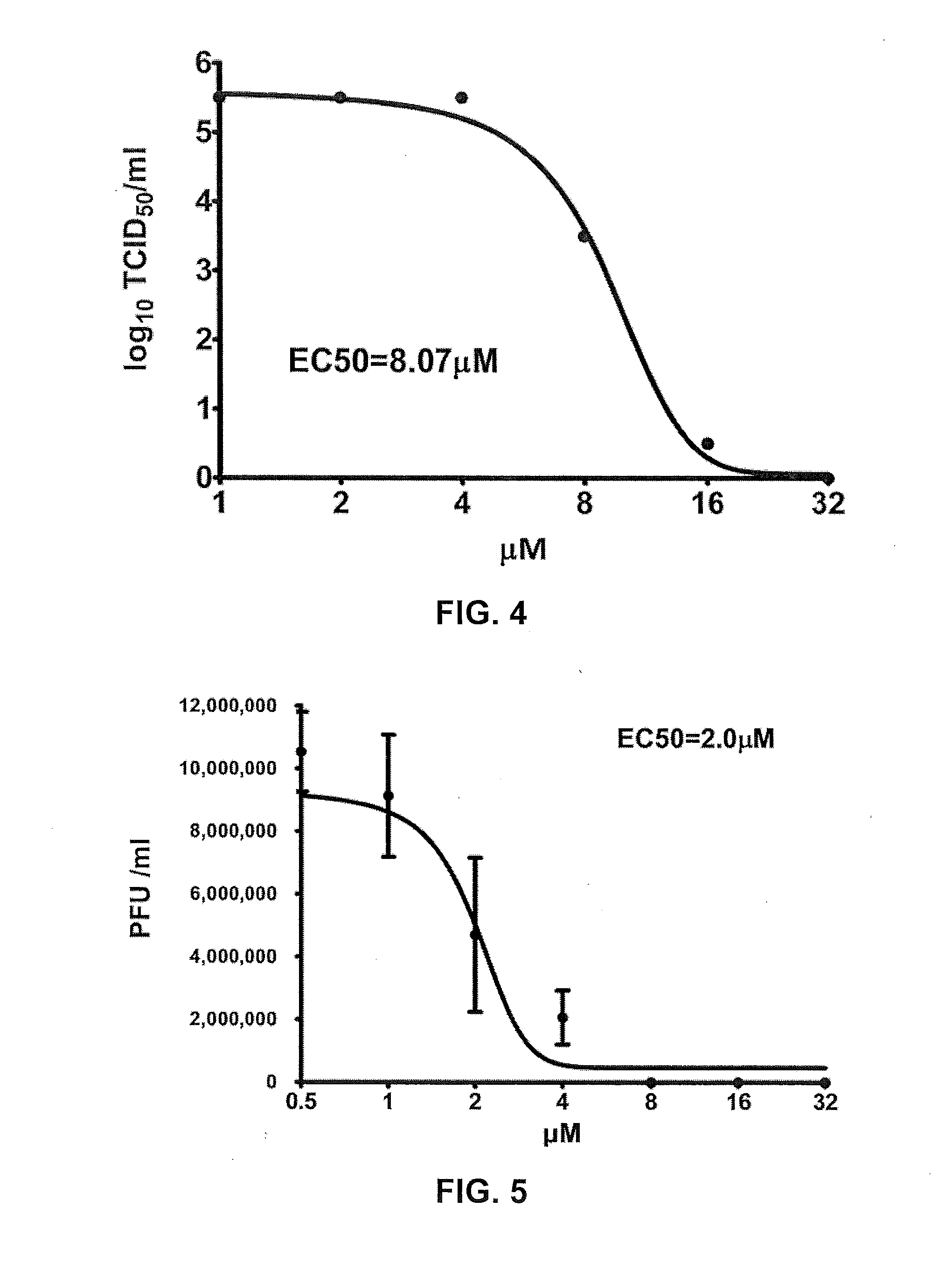Component and method for treating viral disease
a technology for viral diseases and components, applied in the field of biomedicine, can solve the problems of inability to obtain hfmd vaccines and drugs, long time-consuming and labor-intensive vaccination, and inability to achieve large-scale vaccination, etc., and achieve the effect of preventing, reducing, or improving the
- Summary
- Abstract
- Description
- Claims
- Application Information
AI Technical Summary
Benefits of technology
Problems solved by technology
Method used
Image
Examples
example 1
E02 Inhibits EV71 Clinical Isolate (EV71 FY 573) Infection of RD Cells (In Vitro Tests)
[0087]1. E02 can Inhibit EV71 Replication in RD Cells
[0088]RD cells were infected with EV71 clinical isolate (EV71 FY 573) in different E02 concentrations, at the MOI (multiplicity of infection) of 0.1. At 46 h post infection, viral RNA in culture supernatant was extracted, and the relative EV71 viral load was determined by quantitative RT-PCR. Procedures are detailed as follows:
[0089]① Cell seeding: 24 h prior to infection, RD cells were seeded in 96-well cell culture plates, 5×104 cells per well.
[0090]② Infection:[0091]a. Virus pre-incubated with drug: virus stock solution was diluted to 5×104 TCID50 / ml with DMEM and dispensed to 96-well plates at 100 μl per well, and 11 μl of E02 dissolved in DMEM at corresponding concentration or DMEM was added, and incubated at 37° C. for 1 h;[0092]b. Cells pre-incubated with drug: cell culture medium was removed from 96-well plates, each well was added 100 μ...
example 2
E02 inhibits EV71 mouse adapted strain infection in RD cells (in vitro tests)
[0120]1. E02 Reduces EV71 M.a.V. TCID50 in RD Cells
[0121]EV71 M.A.V. in 10-fold serial dilutions was used to infect RD cells at different E02 concentrations. After cultured for 3-4 days, CPE was observed under optical microscope, and stained with crystal violet, to calculate 50% tissue culture infective dose. Specific steps are similar to that for testing corresponding TCID50 of Example 1.
[0122]The results show the EC50 of E02 to reduce EV71 M.A.V. TCID50 in RD cells is 8.07 μM, see FIG. 4. Therefore, E02 reduces EV71 M.A.V. TCID50 in RD cells.
[0123]2. E02 Reduces EV71 M.a.V. PFU in RD Cells
[0124]EV71 M.A.V. was used to infect RD cells cultured in 12-well plates at different E02 concentrations. After cultured for 5 to 7 days, stained and plaque-forming units were calculated. Detailed procedures were the same as the corresponding PFU testing method of Example 1.
[0125]The EC50 of E02 to reduce EV71 M.A.V. PFU...
example 3
E02 Inhibit Coxsackie Virus A16 (CVA16) Infection in RD Cells (In Vitro Tests)
[0127]Coxsackie virus A16 in 10-fold serial dilutions were used to infect RD cells at different E02 concentrations. After cultured for 2 days, CPE was observed under optical microscope, and stained with crystal violet, to calculate 50% tissue culture infective dose. Specific procedures were the same as the TCID50 testing method of Example 1.
[0128]The results show 25 μM of E02 caused CVA16 titer reduction in RD cells from 1×109 TCID50 / ml to 1×104 TCID50 / ml, see FIG. 6. Therefore, E02 reduces CVA16 TCID50 in RD cells.
[0129]Test results of the above Examples 1-3 show E02 can inhibit EV71 and CVA16 infection of RD cells in vitro. E02's EC50 that inhibits EV71 clinical isolate is less than 6.93 μM. 10 μM of E02 can completely inhibit EV71 clinical isolate and mouse adapted strain infection of RD cells and cause CVA16 TCID50 reduction in RD cells.
PUM
| Property | Measurement | Unit |
|---|---|---|
| temperature | aaaaa | aaaaa |
| compositions | aaaaa | aaaaa |
| concentrations | aaaaa | aaaaa |
Abstract
Description
Claims
Application Information
 Login to View More
Login to View More - R&D
- Intellectual Property
- Life Sciences
- Materials
- Tech Scout
- Unparalleled Data Quality
- Higher Quality Content
- 60% Fewer Hallucinations
Browse by: Latest US Patents, China's latest patents, Technical Efficacy Thesaurus, Application Domain, Technology Topic, Popular Technical Reports.
© 2025 PatSnap. All rights reserved.Legal|Privacy policy|Modern Slavery Act Transparency Statement|Sitemap|About US| Contact US: help@patsnap.com



